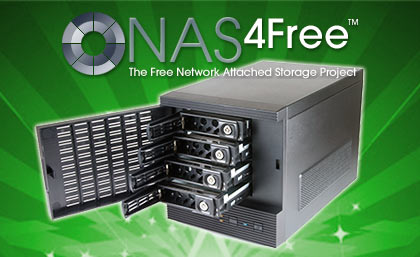Posted on April 9, 2013
Introduction

With so many of our memories and purchases existing only in the digital realm, having a reliable method of storing them is essential. This guide will help you to install NAS4Free - free software which provides several methods of protecting your data by mirroring it across multiple disks.
What does NAS mean?
NAS stands for Network-Attached Storage, or put another way, "Files on your network".
Files become accessible in a number of ways:
- From a Windows, MAC or Linux PC.
- From a DNLA client like Smart-TV or Smart-Phone.
Why NAS4Free?
There are several alternatives to NAS4Free. The ones most often refered to are FreeNAS and OpenFiler. These all provide a simple and flexible way to protect your data.
| NAS4Free | FreeNAS | OpenFiler |
|---|---|---|
| Based on FreeBSD | Based on FreeBSD | Based on Linux |
| Scalable requirements | Version 8 requires at least 4GB (preferably at least 6GB) RAM | Scalable requirements |
| UFS, ZFS Filesystems | UFS, ZFS Filesystems | EXT3, JFS and XFS |
| Install to disk or USB memory stick | Install to disk or USB memory stick | Install to disk or RAID set |
Currently we consider NAS4Free to be the most straightforward and scalable solution. We're also big fans of ZFS, which isn't going to arrive on OpenFiler any time soon due to licencing issues. Scalability makes NAS4Free a good choice for Mini-ITX systems, which can vary from low power consumption Atoms up to powerful Core i7 and Xeon based systems.
This guide concentrates on the software installation and not the myriad of hardware possibilities - contact the Mini-ITX Online Store if you have specific requirements.
Disk Portability
The main benefit of a software-based storage system are disk portability. Let's say that you have a traditional storage device and it becomes faulty. Your data is still on your disk-drives but you cannot access it because the NAS unit is dead. Perhaps it's been several years since you bought the unit and support is no-longer available. Your data could well remain inaccessible.
With NAS4Free you would re-install the software onto completely different hardware, connect your disks and PRESTO your data is back!
Your disks should also be accessible from any other FreeBSD-based system, including FreeNAS.
Should I choose UFS or ZFS?
NAS4Free supports 2 different data-protecting filesystems, UFS and ZFS. The mimimum requirements for a UFS-based system are extremely low. If you have a more powerful machine you could install a ZFS-based system with data de-duplication and compression.
Features and Requirements of UFS and ZFS
| UFS | ZFS | |
|---|---|---|
| Supported Raid Types |
Stripe (RAID0) Mirror (RAID1) RAID3 |
Stripe (RAID0) Mirror (RAID1) RAIDZ1 (RAID5-like) RAIDZ2 (RAID6-like) RAIDZ3 (RAID6+) |
| Minimum Hardware | Any recent 32-bit or 64-bit processor A 512MB USB stick or other flash device |
|
| Memory | Minimum of 512MB of memory | 64-bit processor recommended Minimum of 1GB of memory At least 4GB if using advanced features like snapshots and compression. At least 8GB and a fast processor for de-duping. |
This guide would not have been possible without the hard work of the good people at the NAS4Free project.
Please consider donating to the NAS4Free project!
Start here -->
 |
 |
 |
Quick Links
Mailing Lists:
Mini-ITX Store
Projects:
Show Random
Accordion-ITX
Aircraft Carrier
Ambulator 1
AMD Case
Ammo Box
Ammo Tux
AmmoLAN
amPC
Animal SNES
Atari 800 ITX
Attache Server
Aunt Hagar's Mini-ITX
Bantam PC
BBC ITX B
Bender PC
Biscuit Tin PC
Blue Plate
BlueBox
BMW PC
Borg Appliance
Briefcase PC
Bubbacomp
C1541 Disk Drive
C64 @ 933MHz
CardboardCube
CAUV 2008
CBM ITX-64
Coelacanth-PC
Cool Cube
Deco Box
Devilcat
DOS Head Unit
Dreamcast PC
E.T.PC
Eden VAX
EdenStation IPX
Encyclomedia
Falcon-ITX
Florian
Frame
FS-RouterSwitch
G4 Cube PC
GasCan PC
Gingerbread
Gramaphone-ITX-HD
GTA-PC
Guitar PC
Guitar Workstation
Gumball PC
Hirschmann
HTPC
HTPC2
Humidor 64
Humidor CL
Humidor II
Humidor M
Humidor PC
Humidor V
I.C.E. Unit
i64XBOX
i-EPIA
iGrill
ITX Helmet
ITX TV
ITX-Laptop
Jeannie
Jukebox ITX
KiSA 444
K'nex ITX
Leela PC
Lego 0933 PC
Legobox
Log Cabin PC
Lunchbox PC
Mac-ITX
Manga Doll
Mantle Radio
Mediabox
Mega-ITX
Micro TV
Mini Falcon
Mini Mesh Box
Mini-Cluster
Mobile-BlackBox
Moo Cow Moo
Mr OMNI
NAS4Free
NESPC
OpenELEC
Osh Kosh
Pet ITX
Pictureframe PC
Playstation 2 PC
Playstation PC
Project NFF
PSU PC
Quiet Cubid
R2D2PC
Racing The Light
RadioSphere
Restomod TV
Robotica 2003
Rundfunker
SaturnPC
S-CUBE
SEGA-ITX
SpaceCase
SpacePanel
Spartan Bluebird
Spider Case
Supra-Server
Teddybear
Telefunken 2003
TERA-ITX
The Clock
ToAsTOr
Tortoise Beetle
Tux Server
Underwood No.5
Waffle Iron PC
Windows XP Box
Wraith SE/30
XBMC-ION
